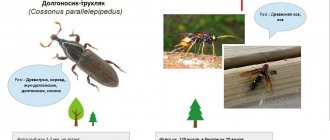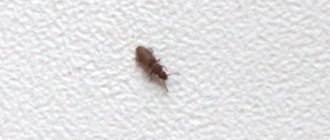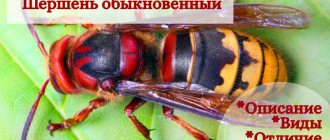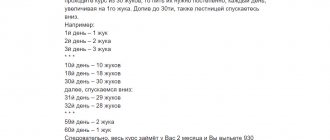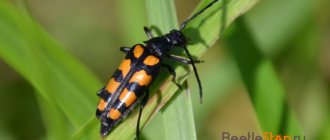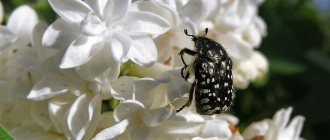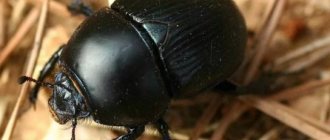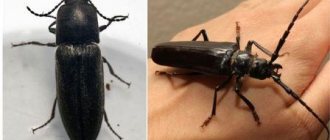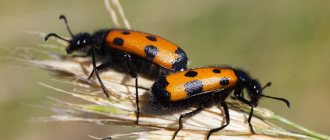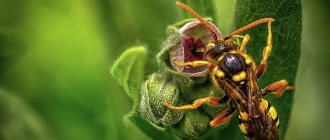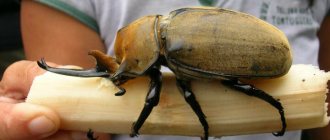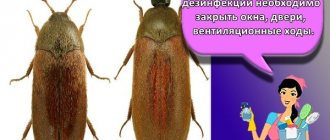The snow beetle is an insect that can cause serious damage to a summer cottage or farm. It is also known as kravchik, strigunets, virgin grass, golovach. It is no coincidence that the pest received its name, because in Ukrainian “kravchik” means “tailor”. The insect, as when cutting clothes, cuts off the plant at the root with its powerful jaws, including even shrubs and vines.
The pest feeds on both garden crops and garden, ornamental plants and even tree shoots.
Attention! The fight against the insect must begin immediately after its appearance, otherwise a significant part of the garden plot will be damaged.
Strigun beetle: photo
Handsome beetle.
Why is it dangerous?
In the wild, the presence of the beetle is practically not felt. Lives in the ground, cuts grass, helps loosen the soil.
But the black beetle in the garden turns into a real agricultural pest.
The insect prefers hard ground, untouched lands, but often approaches human possessions in search of more “tasty” food.
Important! Absolutely all crops in the vegetable garden, flower beds, and gardens can suffer from the activity of beetles. With powerful jaws, pests calmly cut off young shoots, stems, leaves, and flowers.
A dozen adult individuals per season can destroy a young vineyard, a bed of wild strawberries, or strawberries.
Krawczyk is not dangerous to humans; he will never attack first. It may pinch the skin in defense if you pick it up.
Who is the snow beetle?
Name: Strigun beetle or handsome beetle Lat.:
LethrusClass: Insects - Insecta Order: Coleoptera - Coleoptera Family: Dung beetles - Geotrupidae
| Habitats: | Palearctic, fields and steppes |
| Dangerous for: | greenery of various plants |
| Means of destruction: | special drugs, traditional methods |
The snow beetle is a member of the dung beetle family and is also often called the dung beetle, snow beetle, or capitol beetle.
Handsome beetle.
The body length of the swifts is on average 1.5-2.5 cm, and only in rare cases can it reach 3.5 cm. The body, head, legs and jaws of the insect are large and massive. Thanks to this body structure, the beetle easily digs deep holes.
Males have special appendages on their jaws that are shaped like fangs. The insect's paws are covered with many hard hairs, and there are claws at the ends. The flying wings of striguns are reduced, and the elytra are not divided and are more like a hard shell.
The color of the body and limbs of the snow beetle is black, most often matte. Sometimes the color may have a glossy blue tint.
Where does the snow beetle live?
The habitat of representatives of this species is located within the Palearctic. The largest number of snow beetles is concentrated in Central Asia. The conditional extreme points of the range of these beetles are considered to be the Balkan Peninsula in the west, the Orenburg region in the north, Mongolia in the east, Iran and Afghanistan in the south.
A little bit of biology
Longhorned beetles have fairly small sizes (from one to several tens of millimeters), a flat body and mustaches, which are the main organ of smell. The color of lumberjacks is usually brown or dirty gray; less commonly, the longhorn beetle is black. The photo allows you to examine the insect in more detail.
The larvae of the pest are characterized by particularly powerful jaws, thanks to which they can handle both hard wood and soft metal with a cable-type coating. However, the beetles do not eat the latter so readily, preferring wooden structures and stacked boards.
The female barbel lays her eggs (from 200 to 400 pieces) in recesses or cracks in the tree, and after 7-14 days the larvae are born, which instantly activate the process of destroying the tree.
It is worth emphasizing that it is almost impossible to immediately notice a tree disease, since the larvae lead a hidden lifestyle. So, you can understand that your wooden house has succumbed to the harmful effects of longhorned beetles only when the real results of their work (destroyed and loosening wood) are visible.
Lifestyle of the snow beetle
Handsome beetle: aggressive predator.
Swifts live in deep burrows that they dig themselves. The depth of such an underground dwelling can reach 50 cm. Inside the burrow, insects create several branches with small “rooms” at the ends, in which they prepare food for future offspring.
Throughout their lives, adult individuals fill prepared rooms with pieces of green shoots and leaves. Bacteria and fungi process the accumulated greenery and turn it into silage, which the newborn larvae subsequently feed on.
Features
The woodcutter beetle has a number of characteristic features that distinguish this type of pest from many others. These include:
- Long mustache. The longhorned beetle has prominent whiskers that are 2-5 times longer than the insect itself.
- Slender and elongated body. The length of the body varies from 3 to 60 mm.
- Wings. Some species of woodcutter beetles can fly.
- Hair.
What harm does the snow beetle cause?
In the process of stockpiling food supplies, beetles of this species eat almost everything. They destroy:
- young shoots;
- leaves;
- inflorescences;
- kidneys
If no measures are taken to combat the beetles, then only 10 adult individuals can cause serious damage to all plants within 5-7 square meters. Most often, the following crops become victims of striguns :
- sunflower;
- corn;
- garden strawberries;
- grape;
- strawberry;
- decorative flowers.
Lifestyle, nutrition
Zhuk kravchik in Ukrainian means tailor. The insect cuts off plants with its powerful jaws, just as a barber cuts hair. It cuts off leaves, cuttings, shoots, inflorescences, flowers, even young grapevines along the way.
Unlike its relatives, the dung beetle, the snow beetle feeds not on animal excrement, but on grass. It cuts everything in its path - seedlings, garden crops, shrubs, vineyards, ornamental flowers. In one day, the pest is capable of destroying 10 grapevine shoots.
Interesting!
The Strigun insect drags the greenery into a hole and compacts it tightly. Under the influence of bacteria, the reserves begin to rot and turn into silage. This is the main food of adult beetles and their larvae.
Strigun beetle
How to get rid of snow beetles
This type of beetle is quite difficult to drive away from the site. They reproduce very actively, and deep burrows help them hide and wait out treatment with many means.
Special preparations
Treatment with chemicals does not always bring the desired effect in the fight against snow beetles.
Do you use chemicals?
Not really
In order for the drug to have an effect on the pest, it is necessary to carefully treat the entrances to the burrows and the soil around them, as well as the green parts of plants growing nearby.
The best insecticides against snowflakes are:
- Decis;
- Arrivo;
- Diazinon.
Traditional methods
There are not many folk recipes that give results in the fight against harmful beetles. The most effective of them are:
Boiling water or soap solution
One of the selected products is used to fill the insect hole. The procedure should be performed at a time of day when the beetle is likely to be inside - before dawn or after sunset.
Polyurethane foam
This method is indeed very effective in controlling insects, but the problem is that the substances contained in the foam are toxic and can be absorbed into the soil, making it unsuitable for growing crops.
Vegetable oil
A solution of 2 liters of water and 100 ml of oil is poured into the holes. Once the oil enters the respiratory organs of insects, it simply blocks their access to oxygen. As a result, the insects crawl out of their home and die from suffocation.
Digging the soil
Digging up the soil to a depth of 30 cm at least several times a year will regularly destroy the pest’s home and destroy most of the future offspring. It is especially important to carry out the procedure in spring and autumn.
Lifestyle and habitat
The longhorned beetle lives throughout the planet where there are forests. Their distribution depends on the availability of food - mainly trees. The exceptions are the Arctic and Antarctic, precisely because of the lack of food supply.
They are quite active in their lifestyle. They crawl, many very quickly. Some of them can fly. If you pick up a beetle, it makes a characteristic chirping sound. Their lifestyle depends on the climate and habitat.
In the southern regions, these insects “take wing” from mid-spring. Central Asian beetles begin to fly closer to autumn. Some are active during the day, feeding mainly on flowers that open during the day. Others are active at night. Their food does not hide in the dark.
Both nocturnal and daytime beetles find hard-to-reach places to rest or mate. Depending on the size, the flight range is determined. The larger the beetle, the less it flies and the more it crawls. They lead a very secretive lifestyle. Seeing an adult beetle in the forest is a real gift for an entomologist and an alarming signal for a forester.
Hair beetle
Hair chewer.
People used to scare fashionistas with a beetle or a hair-cutter. Allegedly, if this creature gets tangled in hair, it will create a large bald spot, cutting off the hair with an unpleasant grinding sound. But another beetle is considered a hairbiter - the spruce or pine longhorned beetle .
It terrifies many people. Often, during the hottest season, the swift beetle sits on people's light-colored clothing or bare parts of the body to cool down and rest. They look intimidating, but apart from an unpleasant image, they do nothing bad to people. They feed on coniferous wood, but are not so common as to be a serious pest.
Types of longhorned beetles
There are many longhorned beetles, depending on certain characteristics they are combined into groups. Thus, woodcutter beetles that specialize in the destruction of spruce, pine and fir trees include the short-whiskered beetle, the shiny-breasted beetle, the ribbed beetle and the rustic beetle. The second group: large and small ragii, black spruce longhorned beetle, and bronze pine pest. They gnaw the needles, thereby damaging the health of the tree, and then settle into its wood. It is the active activity of pest beetles of the second group that is the most common cause of the extinction of entire areas of forested areas. The third group of longhorned beetles are squeaky beetles. They prefer deciduous trees, including birch, aspen, and willow. These include the greater and lesser squeakers, marbled squeakers, musky barbels, spiny barbels, as well as certain species of sandpipers.
Agrotechnical methods
The snow beetle is unusually tenacious, so the most important weapon against it is the timely implementation of such agrotechnical measures as:
- pre-winter and early spring mechanical tillage (digging, plowing, loosening);
- cleaning and disposal of fallen leaves, tops, old mulch;
- timely weeding of rows;
- mulching the soil under plants with sawdust, pine needles or crushed bark, straw;
- application of insecticides of contact-intestinal action (Volaton) during digging (ploughing) of the soil;
- treatment of edge strips of the site with chemicals;
- spraying wastelands adjacent to the treated area with an 80% aqueous suspension of chlorophos.
Another successful solution to the problem is the construction of trapping ditches: along the border of the site, a trench is dug with steep walls 20-25 cm wide and about 30 cm deep. Flightless crabs caught in the trap cannot get to the surface, and all you have to do is destroy them. As traps, you can use old buckets, halves of plastic bottles, pieces of pipes of a suitable size, dug into places where beetles accumulate.
Continuation of life
Longhorn beetles breed in areas where there is silence and at altitude.
An excellent place - roof crossbars, tall trees. This is where mating takes place. During the mating season, females secrete a special liquid that is attractive to the “male half”. Insects are not averse to sexual games lasting up to half an hour. The fertilized individual is looking for a secluded place for a nest in order to lay a clutch in the future. There can be more than a hundred eggs in one place. Soon the adult dies. Her life on average lasts up to a month.
The male does not leave the female, he moves after her and waits for offspring. After two weeks, voracious larvae hatch. Everything that surrounds them serves as food for them.
This is interesting!
The longhorned beetle family includes not only annoying wood pests, but also representatives of the Red Book of Russia. One of them is the relict longhorned beetle (woodcutter). Its habitat is the deciduous forest of the Far East. A distinctive feature is the body length, reaching 11 centimeters. Meeting such a beetle is a great success. The titan lumberjack, which has received the status of “the largest beetle on the planet,” and the long-legged harlequin, whose front limbs are longer than the length of the body, also need protection.
Where can I meet you?
The longhorned beetle can live and reproduce not only in various tree species, but also in shrubs and herbaceous plants. Longhorned females lay their eggs in a crack in tree bark, in depressions on branches, trunks or stems. Moreover, the pests make these cracks and gouges themselves.
Lumberjacks can “visit” you at your dacha, and the forestry industry can “boast” of such guests. In country houses, the objects of pest attack are furniture, boards and other wood products.
What happens to the larvae
This can be said about light or milky-colored, fleshy-yellow larvae of a flattened shape. Convex limbs allow future insects to move along the surface. The head is black with healthy jaws. With them they easily gnaw the inside of the tree, so they have enough nutrition. Gradually, only dust remains from the tree trunks. Then the larva will have to look for a new place of “residence”.
Those who live in the grass, on plant stems, have an elongated long body, similar to a cylinder, with hairs at the ends of the body.
Well formed sternum. The gluttony of the larvae is amazing - in a day they can increase their mass to twice their original weight. This law of nature operates to produce a full-fledged beetle, because... on summer days, a mature individual eats practically nothing - just grass and flowers. Moments were noted when bark beetle larvae completely destroyed human wooden buildings located in one block. Autumn is coming to an end. The beginning of winter is the time of pupation of the larvae. Spring is the stage of metamorphosis of a beetle into an adult insect. If the larva is hidden deep in the plant and is reliably protected, then the individual can survive in this state for decades. The fact of drilling a “passage” of up to 50 km has been recorded, taking into account the fact that up to 3 cm of wood is gnawed per day.
The free pupal stage lasts about 40 days. The color of the body changes, yellowness appears, the rudiments of wings and antennae are visible, the limbs are closely pressed. The head is located almost at the chest, the antennae are hidden between the legs. The pupae may have spines and short hairs.
The larva first builds a shelter in a tree trunk, ground, stems, and pupation begins there.
Name
The family name Cerambycidae is a Latin neologism that did not exist in classical Latin, but was created in the time of Carl Linnaeus. It is formed by the comparison of two words: the ancient Greek ceros - “horn” and the Latin bis - “two”, which means “two-horned”. This name reflects the characteristics of the antennae of longhorned beetles - the length and their forward direction during life, associated with horns. In many Western and Central European languages, the name barbel is associated specifically with horns: English. Longhorn beetle, fr. Longicornes, Spanish Escarabajos longicornios, German. Bockkafer, Polish. Kózkowate and the like. At the same time, two distinct names were established in southern and eastern European languages. The first associates antennas with mustaches: Russian. mustache, Ukrainian vusachi, white vusachis and the like. The second is with feeding on wood at the larval stage: Rus. woodcutters, white Dryvaseki, Bulgarian Seckovci, Czech. Tesaříkovití, etc.
Musk barbel
In the Ukrainian language, in addition to the generally accepted and basic name “usachi”, the following are also known: skripuni, skripunuvati, dovgorozhtsi, kovzani and cossacks. The names “skripuni” and “skripunuvati” are associated with behavioral features - suddenly seized imago barbels make a creaking sound, rubbing the pronotum against the mesonotum; the name “Dovgorozhtsi” indicates the similarity of the antennae with horns; “Kovzani” (Russian “skates”) - for the similarity of the antennas with the skates (runners) of a sled; “Cossacks” - for the similarity of the antennae with the long mustaches of the Cossacks.
Wood processing by professionals
It is often difficult to cope with the task on your own, at home. In this case, you can invite professionals who:
- The wood will be treated using fumigation.
- Microwave disinfestation will be carried out.
Each method has both advantages and disadvantages.
Fumigation
This is a method of treating wood with poisonous gases. Nowadays, this method is not often used, since the gas does not have high permeability and it is not possible to destroy the larvae inside the wood.
There is a similar method when drugs, in the form of tablets, decompose when exposed to air. As a result, phosphine gas is released. In one day, the product destroys all beetles and larvae, as well as eggs. The tablets decompose within 2 days.
Advantages of this method:
- Possibility of 100% destruction of all pests.
- The warranty covers 10 years.
- It is possible to cover a large area in a short period of time.
The disadvantage of the method is the high toxicity of the substance.
Microwave disinsection
Eggs and larvae die at temperatures of +55 degrees and above. If they are exposed to microwave installations that emit microwave waves, then the eggs and larvae begin to heat up, which is why they die. Microwave waves do not cause any harm to wood.
Advantages of the method:
- Microwave devices are safe for both people and pets.
- The method allows you to quickly and effectively get rid of pests.
- The method works in all weather conditions.
The only drawback is the nature of the work, since you have to look for places where woodcutter beetle larvae spoil the wood. Therefore, specialists use a special device - a stethoscope. Using this device, they listen to the house meter by meter and determine where the larvae are.
